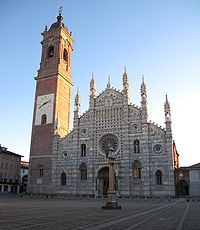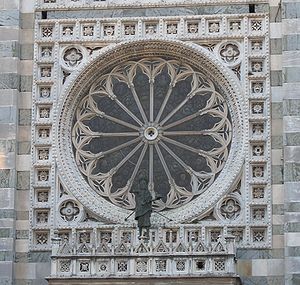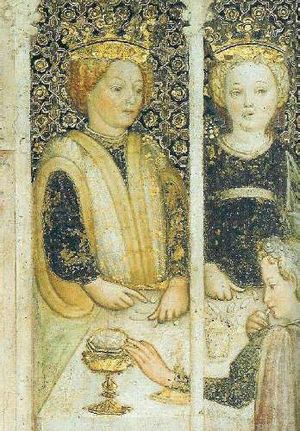
Monza Cathedral
Encyclopedia

Monza
Monza is a city and comune on the river Lambro, a tributary of the Po, in the Lombardy region of Italy some 15 km north-northeast of Milan. It is the capital of the Province of Monza and Brianza. It is best known for its Grand Prix motor racing circuit, the Autodromo Nazionale Monza.On June...
, near Milan
Milan
Milan is the second-largest city in Italy and the capital city of the region of Lombardy and of the province of Milan. The city proper has a population of about 1.3 million, while its urban area, roughly coinciding with its administrative province and the bordering Province of Monza and Brianza ,...
, in northern Italy
Italy
Italy , officially the Italian Republic languages]] under the European Charter for Regional or Minority Languages. In each of these, Italy's official name is as follows:;;;;;;;;), is a unitary parliamentary republic in South-Central Europe. To the north it borders France, Switzerland, Austria and...
. Unlike most duomo
Duomo
Duomo is a term for a cathedral church. The formal word for a church that is presently a cathedral is cattedrale; a Duomo may be either a present or a former cathedral . Some, like the Duomo of Monza, have never been cathedrals, although old and important...
s it is not in fact a cathedral, as Monza has always been part of the Diocese of Milan, but is in the charge of an archpriest
Archpriest
An archpriest is a priest with supervisory duties over a number of parishes. The term is most often used in Eastern Orthodoxy and Eastern Catholic Churches, although it may be used in the Latin rite of the Roman Catholic Church instead of dean or vicar forane.In the 16th and 17th centuries, during...
who has the right to certain episcopal vestments including the mitre
Mitre
The mitre , also spelled miter, is a type of headwear now known as the traditional, ceremonial head-dress of bishops and certain abbots in the Roman Catholic Church, as well as in the Anglican Communion, some Lutheran churches, and also bishops and certain other clergy in the Eastern Orthodox...
and the ring. The church is also known as the Basilica of San Giovanni Battista from its dedication to John the Baptist
John the Baptist
John the Baptist was an itinerant preacher and a major religious figure mentioned in the Canonical gospels. He is described in the Gospel of Luke as a relative of Jesus, who led a movement of baptism at the Jordan River...
.
History
The basilica, which would in essence have been complete by 603 when heir to the Lombard throneKingdom of the Lombards
The Kingdom of the Lombards or Lombard Kingdom was an early medieval state, with its capital in Pavia, established by the Lombards on the Italian Peninsula between 568-569 and 774 .Effective control by the rulers of both the major areas that constituted the...
Adaloald
Adaloald
Adaloald was the Lombard king of Italy from 616 to 626. Son and heir of King Agilulf and his Catholic queen Theodelinda, he was baptised shortly after his birth in 602. He was an associate king, raised on the shield by the warriors at his father's request, when still young...
was baptised here by Secundus of Non
Secundus of Non
Secundus of Non or Trent was an adviser at the court of the Lombard king Agilulf . He wrote a now lost history of the Lombards which Paul the Deacon used in his Historia Langobardorum. "He seems to have known much about the early Lombard leaders, but very little about how and where the Lombards...
, is believed to have been commissioned towards the end of the seventh century by the Lombard
Lombards
The Lombards , also referred to as Longobards, were a Germanic tribe of Scandinavian origin, who from 568 to 774 ruled a Kingdom in Italy...
Queen of Italy, Theodelinda
Theodelinda
Theodelinda, queen of the Lombards, was the daughter of duke Garibald I of Bavaria.She was married first in 588 to Authari, king of the Lombards, son of king Cleph. Authari died in 590. Theodelinda was allowed to pick Agilulf as her next husband and Authari's successor in 591...
, as a royal chapel to serve the nearby palace.
According to the legend she had made a vow to build a church dedicated to Saint John the Baptist
John the Baptist
John the Baptist was an itinerant preacher and a major religious figure mentioned in the Canonical gospels. He is described in the Gospel of Luke as a relative of Jesus, who led a movement of baptism at the Jordan River...
, and when riding along the banks of the Lambro
Lambro
For the river in Cilento, see Lambro . For the genus, see Lambro .The Lambro is a river of Lombardy, northern Italy, a left tributary of the Po....
River, she was halted by a dove who told her Modo (Latin for "now"), to which she replied Etiam ("yes"). Monza itself was initially known as Modoetia.
In 595, she had a oraculum (chapel) built on the Greek Cross plan; of this chapel only the walls exist today. The queen was buried here, in what is now the central left aisle of the church. On the remains of the oraculum, a new church was erected in the 13th century. It was again rebuilt as a basilica, starting from 1300, on a Latin Cross plan with an octagonal tiburium. In the late 14th century, the side chapels were added and, as designed by Matteo da Campione, the Pisan-Gothic style west front in white and green marble was begun.
Starting from the 16th century, the choir and the ceiling were restored. Subsequently, the walls and the vaults were decorated with frescoes and stucco-work. The bell tower was erected in 1606. In the 18th century a cemetery was annexed on the left side.
West front
The massive west front is divided into five parts by six lisene (applied strips), each of which is surmounted by a tabernacle housing a statue. The façade has several mullioned windows with, in the centre, a large rose windowRose window
A Rose window is often used as a generic term applied to a circular window, but is especially used for those found in churches of the Gothic architectural style and being divided into segments by stone mullions and tracery...
framed by a motif inspired by Roman antique ceilings, decorated with rosettes, masks and star motifs.


Romanesque architecture
Romanesque architecture is an architectural style of Medieval Europe characterised by semi-circular arches. There is no consensus for the beginning date of the Romanesque architecture, with proposals ranging from the 6th to the 10th century. It developed in the 12th century into the Gothic style,...
in its structure and Gothic
Gothic art
Gothic art was a Medieval art movement that developed in France out of Romanesque art in the mid-12th century, led by the concurrent development of Gothic architecture. It spread to all of Western Europe, but took over art more completely north of the Alps, never quite effacing more classical...
in its decoration. Typical of the latter is the porch, with 14th century gargoyle
Gargoyle
In architecture, a gargoyle is a carved stone grotesque, usually made of granite, with a spout designed to convey water from a roof and away from the side of a building thereby preventing rainwater from running down masonry walls and eroding the mortar between...
s on the sides and the 13th century lunette
Lunette
In architecture, a lunette is a half-moon shaped space, either filled with recessed masonry or void. A lunette is formed when a horizontal cornice transects a round-headed arch at the level of the imposts, where the arch springs. If a door is set within a round-headed arch, the space within the...
with the 16th century busts of Theodelinda and King Agilulf
Agilulf
Agilulf called the Thuringian, was a duke of Turin and king of the Lombards from 591 until his death.-Biography:A relative of his predecessor Authari, he was selected king on the advice of the Christian queen and widow of Authari, Theodelinda, whom he then married...
. Over the porch is the statue of Saint John the Baptist
John the Baptist
John the Baptist was an itinerant preacher and a major religious figure mentioned in the Canonical gospels. He is described in the Gospel of Luke as a relative of Jesus, who led a movement of baptism at the Jordan River...
(15th century). Over the portal is depicted the Baptism of Jesus
Baptism of Jesus
The baptism of Jesus marks the beginning of Jesus Christ's public ministry. This event is recorded in the Canonical Gospels of Matthew, Mark and Luke. In John 1:29-33 rather than a direct narrative, the Baptist bears witness to the episode...
, assisted by Saint Peter
Saint Peter
Saint Peter or Simon Peter was an early Christian leader, who is featured prominently in the New Testament Gospels and the Acts of the Apostles. The son of John or of Jonah and from the village of Bethsaida in the province of Galilee, his brother Andrew was also an apostle...
, the Blessed Virgin Mary, Saint Zachary
Zechariah (priest)
In the Bible, Zechariah , is the father of John the Baptist, a priest of the sons of Aaron, a prophet in , and the husband of Elisabeth who is the cousin of Mary the mother of Jesus.In the Qur'an, Zechariah plays a similar role as the father of John the Baptist and ranks him as a prophet alongside...
and Saint Paul. In the upper section is portrayed Theodelinda offering to John the Baptist the Iron Crown of Lombardy
Iron Crown of Lombardy
The Iron Crown of Lombardy is both a reliquary and one of the most ancient royal insignia of Europe. The crown became one of the symbols of the Kingdom of Lombards and later of the medieval Kingdom of Italy...
, together with her kneeling husband Agilulf and their children Adaloald
Adaloald
Adaloald was the Lombard king of Italy from 616 to 626. Son and heir of King Agilulf and his Catholic queen Theodelinda, he was baptised shortly after his birth in 602. He was an associate king, raised on the shield by the warriors at his father's request, when still young...
and Gundeberga
Gundeberga
Gundeberga or Gundeperga, queen of the Lombards, was the daughter of Theodelinda and her first husband, the Lombard king Authari. She married Arioald, who was king of the Lombards from 626 until his death in 636....
.
Interior
The church has a nave and two aisles, separated by octagonal columns with Romanesque capitals and round columns with Baroque capitals. It ends in large apses, and has a series of chapels opening into the aisles.The wall decoration is overwhelmingly Baroque. Other artworks include a choir by Matteo da Campione, the high altar by Andrea Appiani
Andrea Appiani
Andrea Appiani was an Italian neoclassical painter.-Biography:He was born in Milan. He had been intended to follow his father's career in medicine but instead entered the private academy of the painter Carlo Maria Giudici . He received instruction in drawing, copying mainly from sculpture and prints...
, and the presbytery and transept frescoes by Giuseppe Meda
Giuseppe Meda
Giuseppe Meda was an Italian painter, architect and hydraulics engineer.Born in Milan, he apprenticed as painter under Bernardino Campi...
and Giuseppe Arcimboldi.
Treasury
In the right transept is the entrance to the Serpero Museum which houses the treasury with the Iron Crown of LombardyIron Crown of Lombardy
The Iron Crown of Lombardy is both a reliquary and one of the most ancient royal insignia of Europe. The crown became one of the symbols of the Kingdom of Lombards and later of the medieval Kingdom of Italy...
, and the Late Antique ivory Poet and Muse diptych
Poet and Muse diptych
The Poet and Muse diptych is a Late Antique ivory diptych that appears to commemorate, and to flatter, the literary pursuits of the aristocrat who commissioned it, so that it stands somewhat apart from the consular diptychs that were carved for distribution to friends and patrons when a man assumed...
, of about 500, as well as an internationally important collection of late antique and early medieval works of various kinds, many deposited by Theodelinda herself. These includes small metal 6th century ampullae
Monza ampullae
The Monza ampullae form the largest collection of a specific type of Early Medieval pilgrimage ampullae or small flasks designed to hold holy oil from pilgrimage sites in the Holy Land related to the life of Jesus, that were made in Palestine, probably in the fifth to early seventh centuries...
from the Holy Land
Holy Land
The Holy Land is a term which in Judaism refers to the Kingdom of Israel as defined in the Tanakh. For Jews, the Land's identifiction of being Holy is defined in Judaism by its differentiation from other lands by virtue of the practice of Judaism often possible only in the Land of Israel...
which are evidence of the emerging iconography
Iconography
Iconography is the branch of art history which studies the identification, description, and the interpretation of the content of images. The word iconography literally means "image writing", and comes from the Greek "image" and "to write". A secondary meaning is the painting of icons in the...
of medieval art, among them the earliest depictions of the treatments of the Crucifixion and Nativity of Jesus in art
Nativity of Jesus in art
The Nativity of Jesus has been a major subject of Christian art since the 4th century. The artistic depictions of the Nativity or birth of Jesus, celebrated at Christmas, are based on the narratives in the Bible, in the Gospels of Matthew and Luke, and further elaborated by written, oral and...
that were to become standard throughout the Middle Ages and beyond. Only Bobbio
Bobbio
Bobbio is a small town and commune in the province of Piacenza in Emilia-Romagna, northern Italy. It is located in the Trebbia River valley southwest of the town Piacenza. There is also an abbey and a diocese of the same name...
has an equivalent collection of ampullae. The library holds a number of old and important illuminated manuscript
Illuminated manuscript
An illuminated manuscript is a manuscript in which the text is supplemented by the addition of decoration, such as decorated initials, borders and miniature illustrations...
s.
Theodelinda Chapel
Apart the Iron Crown, the most famous attraction of the church is the Chapel of Theodelinda. It has 15th-century frescoes from the ZavattariZavattari
The Zavattari were a family of Italian painters active in Lombardy from the 14th to the 16th century.Cristoforo and Franceschino Zavattari are known as collaborators to the decoration of the Duomo of Milan in the early 15th century...
workshop depicting the stories of the queen's life, such as the dove episode, her marriage proposal, her meeting with her first husband, Authari
Authari
Authari also known as Agilolf, was king of the Lombards from 584 to his death. After his father, Cleph, died in 574, the Lombardic nobility refused to appoint a successor, resulting in ten years interregnum known as the Rule of the Dukes.In 574 and 575 the Lombards made the blunder of invading...
, the latter's death in battle, and her new marriage with Agilulf. All the figures are portrayed with rich garments typical of the Visconti
House of Visconti
Visconti is the family name of two important Italian noble dynasties of the Middle Ages. There are two distinct Visconti families: The first one in the Republic of Pisa in the mid twelfth century who achieved prominence first in Pisa, then in Sardinia where they became rulers of Gallura...
era.
The vault is decorated with 14th century figures of saints and evangelists enthroned. On the outer arch are depicted Theodelinda with her court venerating Saint John the Baptist.
The Alabardieri guard
An ancient and unusual privilege of the Duomo is its right to employ ceremonial armed guards, rather on the line of the Papal Swiss Guard at the Vatican. Known as Alabardieri from the halberdHalberd
A halberd is a two-handed pole weapon that came to prominent use during the 14th and 15th centuries. Possibly the word halberd comes from the German words Halm , and Barte - in modern-day German, the weapon is called Hellebarde. The halberd consists of an axe blade topped with a spike mounted on...
s they carry, the date of their institution is described in a 1763 edict of Maria Theresa of Austria
Maria Theresa of Austria
Maria Theresa Walburga Amalia Christina was the only female ruler of the Habsburg dominions and the last of the House of Habsburg. She was the sovereign of Austria, Hungary, Croatia, Bohemia, Mantua, Milan, Lodomeria and Galicia, the Austrian Netherlands and Parma...
as ‘immemorial’. Their eighteenth-century style uniform, of blue wool with gold braiding and a belt buckle with an image of the Iron Crown, is unchanged from that approved in the edict, except that since the Napoleonic period the bicorne
Bicorne
The bicorne or bicorn is an archaic form of hat widely adopted in the 1790s as an item of uniform by European and American military and naval officers...
hat has replaced the earlier tricorne
Tricorne
The tricorne or tricorn is a style of hat that was popular during the 18th century, falling out of style by 1800. At the peak of its popularity, the tricorne was worn as civilian dress and as part of military and naval uniforms...
.

